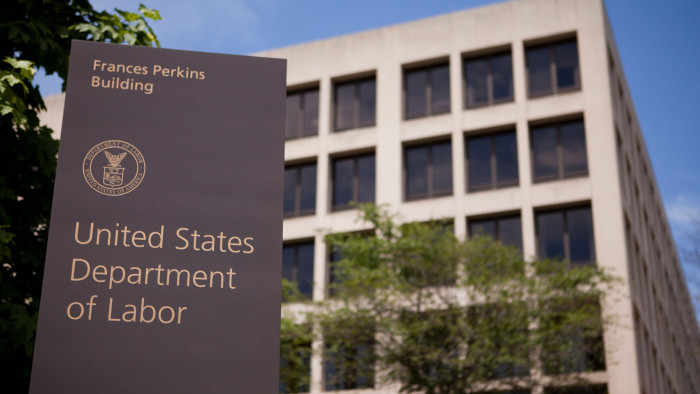Expect more ethical saving options for 401(k) plans

Simply sign up to the ESG investing myFT Digest -- delivered directly to your inbox.
Molasses runs downhill faster than the US 401(k) industry adapts to new investment trends, according to pension advisers.
Sponsors of defined contribution retirement plans — usually employers — typically make decisions in company committees that are subject to substantial regulatory oversight, which may explain their hesitance.
Such dynamics could also be the reason why socially responsible and impact investing criteria, which are becoming fashionable elsewhere, are absent from most 401(k) plans.
A survey this year of 216 FT401 advisers by Ignites Research, owned by the Financial Times, found that 52 per cent have some client assets held for retirement plans that happen to use environmental, social and governance (ESG) criteria.
However, fewer than 15 per cent of the advisers’ clients, the companies that sponsor retirement plans, have given employees the choice of ESG or impact investing options, according to a range of FT 401 advisers interviewed separately for this story.
The Ignites Research survey also discovered that those clients that have ESG in defined contribution plans use it sparingly: an average of 3.4 per cent of plan assets are in ESG.
“Unfortunately, the retirement plan industry is slow to adopt changes,” says Lisa Petronio, an adviser with Strategic Retirement Partners in New York state.
But ESG and impact investment in US defined contribution retirement plans could be set for a boost.
Within six years, demographic changes will mean more than half the US workforce will be millennials or younger, according to a forecast by Inc magazine. Millennials rank as the demographic group most eager to invest using ESG and impact criteria, according to a Bank of America study.

As employers take on more young people, they are likely to face greater pressure to have ESG options in retirement plans.
More ESG and social impact investment products are available than at the start of the decade, says Morningstar, the data provider. The increased supply has reduced the cost of ESG and social impact funds, say advisers.
Asset managers have also begun pressing companies to provide more transparent ESG and social impact data, which will make it easier for plan advisers and sponsors to have confidence in their evaluation of a fund’s underlying investments.
“ESG investors have long struggled to find a consistent approach to defining whether an investment aligns with an ESG philosophy. Now, asset managers are pursuing solutions to help,” State Street Global Advisors, the Boston-based investment manager, wrote in its June bulletin.
All these trends will spur retirement plan sponsors and their advisers to add ESG and social impact options, advisers say.
Another prompt is likely to be a surge of interest from retirement plan financial advisers. The Ignites Research survey showed that 46 per cent of advisers who had no ESG products in clients’ defined contribution plans wanted to learn more about the topic. “The good news [is] there is more and more information,” says Rita Fiumara, a senior vice-president with UBS in Chicago, who advises retirement plan sponsors.
All told, expect to see more ESG options in retirement plans, says Eric Bailey, an institutional adviser at CapTrust in Tampa, Florida. He says: “I see it increasing because of the large social justice movement: women’s rights, equal pay, environmental issues, gun control. There is demand.”
President Trump’s administration has done little to encourage the growth of ESG investment in defined contribution retirement plans despite its growing popularity.
Under his predecessor Barack Obama, the Department of Labor had issued guidance that “corrected a misperception that investments in [economically targeted investments] are incompatible with . . . fiduciary obligations.” But, in April 2018, the DOL issued a bulletin saying that “fiduciaries must not too readily treat ESG factors as economically relevant to the particular investment choices at issue when making a decision”.

That language did not give advisers and sponsors confidence. “The DoL guidance is still a little confusing. They changed their stance to ESG. It’s still not super clear,” says Ms Petronio.
Historically, even when regulators provide clarity, retirement plan sponsors still adopt ideas slowly.
In 2006, DoL rules permitted retirement plan sponsors to allow participants to make post-tax contributions (known as Roth contributions) to their accounts. This allows them to withdraw money from the accounts tax free after they reach retirement age, an option not available with their traditional tax-deferred contributions.
Today — 13 years later — fewer than seven in 10 US defined contribution retirement plans have adopted the Roth option, according to the Plan Sponsor Council of America.
Erik Tappin, corporate retirement director for Morgan Stanley in Carlsbad, California, says all his corporate clients have Roth options in their plans. He is, however, only too aware that clients’ committees can take their time to decide on something new. One group has spent 18 months talking about adding an ESG option but has yet to do so.
That said, 30 per cent of his clients, up from 10 per cent a year ago, have made ESG funds available for plan participants. About 75 per cent, up from 30 per cent a year ago, have begun talking about adding ESG options. “There is a lot of interest in education before action is taken,” Mr Tappin says.
Despite the hesitancy, Daniel Ketchum, who advises sponsors for Raymond James, a broker-dealer in Irvine, California, predicts that younger employees will press for ESG options. His daughter did just that.
“Dad, this has an oil company. I’m protesting about oil companies,” Mr Ketchum recalls his daughter saying as he helped her select funds for her own retirement plan.
At her insistence, Mr Ketchum engaged in a thorough search of ESG and impact funds to select one for his daughter as well as his retirement plan corporate clients.
Comments